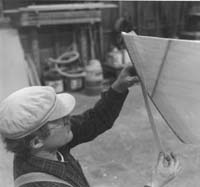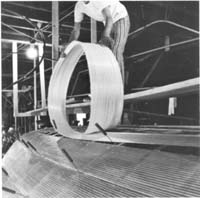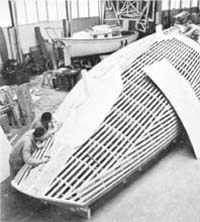HOW PLYWOOD, ALUMINUM, & STEEL HULLS ARE BUILT...
Hulls made from these sheet materials are usually built upside down over a form or "jig" (see below for Stitch & Glue plywood variations or if working from hull plating kits in the case of some aluminum designs). Frames or ribs (which may or may not remain in the hull depending on size and type) are then erected onto this jig for accuracy and strength. Lengthwise stiffeners are then bent around this framework to reinforce the hull-covering material, thus completing the basic backbone or "skeleton" of the hull.
With the hull so framed, sheet plywood or metal panels (which usually need not be full length initially) are temporarily leaned against the framework, marked to rough oversize, removed, cut to the marks, and then repositioned and fastened or welded in place. No separate patterns or layouts are necessary to determine these panel shapes since the underlying framework does this for you with speed and accuracy.
Because boats designed for these sheet materials are specially developed and contoured, no special panel forming or difficult bending is necessary. Construction proceeds rapidly. Righting a hull after panel application can be done by rolling the hull over manually, or by using a gin pole setup, chain fall, or light crane for bigger hulls. Many of the books we offer explain these procedures which are easier than most people think. On our bigger steel designs, some choose to build right side up which is also optional.
WOOD
Low-cost and user-friendly, our EPOXY glues and encapsulating resin processes have revolutionized and simplified wood methods, making wood ideal even for first-time builders. All the old arguments against wood - rot, leaks, worm damage, undue maintenance, etc. - become things of the past. Check below for details on the various wood methods our plans may specify.
PLYWOOD
Strong, lightweight, inexpensive, and fast to build, this sheet material is ideal for the inexperienced. Longevity, low maintenance, and durability are assured by our easy-to-apply EPOXY encapsulation coatings and outer FIBERGLASS COVERING KITS we have available. We offer a wide selection of plywood designs and related "how-to" books.
STITCH & GLUE PLYWOOD
 |
 |
 |
|
Fig. 1 - Plywood panels are wired or "stitched" together intermittently to form basic hull shape. |
Fig. 2 - Interior joints are bonded together with epoxy filler shaped into a concave fillet made from epoxy and fillers we sell. |
Fig. 3 - Wires are removed and bonded seams covered with woven fiberglass tapes inside and out. |
At left, sections through bottom/side junction show sequence of steps used in Stitch & Glue method. "A" shows junction wired together with short lengths of ordinary wire twisted tautly. "B" shows epoxy filler applied in a concave-shaped fillet to bond the panels together. Once cured, wires can be removed or snipped off flush. "C" show inside of junction covered with fiberglass tape wetted out with resin. Outside corner is rounded off and covered with additional tape on the exterior. In addition, another layer of fiberglass is also applied over the entire exterior of the hull.
This plywood method needs no internal backing members, frames, or fastenings(*). Just cut panels to shape from dimensions or patterns we provide, and wire together to form the hull. NO LOFTING REQUIRED! Epoxy filler is then worked and shaped into the joints to bond members together. Wire ties are snipped off or pulled out later, and fiberglass tape from the kit applied inside and out at these joints. It's FAST, STRONG, & SUPER-EASY even if it's your first boat.
(*)Some additional internal plywood stiffening members such as bulkheads may be called for and added later into the hull depending on the design.
COLD MOLDING (DOUBLE DIAGONAL) PLANKING
 |
 |
 |
|
Photo shows double diagonal process using plywood cut in strips on the bottom of this boat. Note the curvature developing that would not be possible if a sheet material alone was used. |
Cold molded boats can be either round bilge (as shown here), or hard-chined as shown at left. In either case, planking is largely glued (epoxy) and fastened to longitudinal stringers notched into frames or bulkheads that may be spaced farther apart than might be the case with more-traditional planking methods. More about cold molding HERE |
This round bilge hull is being built with a combination of cold molded substrate with a strip planked layer on the outside. The sequence could also be reversed if desired, and is described in books we sell. |
STRIP PLANKINGNarrow strips of wood are epoxy edge-glued and/or fastened together. One edge is usually coved; the other convex radiused ("bead") for a tight fit over curved hull surfaces. Such hulls need little internal framing and are well suited to amateurs. Sometimes combined with cold molding, we have books that explain the details. We advise using a sheathing of epoxy and fiberglass on the outside after. More Strip Planking |
|
ALUMINUM
 Anyone who can weld aluminum can build a boat with this proven material, even first-timers. Special finishes are not required and it's virtually maintenance-free. Super-strong and light weight, we have many aluminum designs and books on the subject.
Anyone who can weld aluminum can build a boat with this proven material, even first-timers. Special finishes are not required and it's virtually maintenance-free. Super-strong and light weight, we have many aluminum designs and books on the subject.
More Aluminum
STEELThe strongest and lowest-cost of boatbuilding materials is also one of the easiest for the do-it-yourselfer who can weld, even first-time builders. New coating systems and building techniques detailed in the books we offer on steel boatbuilding virtually eliminate rust problems. "Shrink Wrap" Steel Pictorial |
 |
FIBERGLASS
 |
 |
 |
|
Our proven "one-off" methods make it easy for do-it-yourselfers to turn out boats that look factory-built. Materials such as C-FLEX and sandwich cores eliminate the need for female molds and plugs, or special skills. |
||

